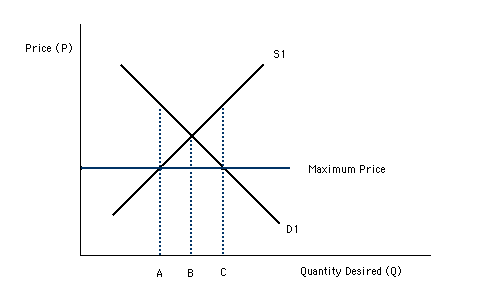Sometimes I struggle to choose a title for my posts. You see, there are many times that a potential reader will glance at a title and read or skip the post based on those few words. Other titles I considered for todays were, “Did Congressman Hinchey cut class that day?”, “Stupid Congressional Tricks”, “Repealing the Law of Supply and Demand”, and “Hinchey is a @#$%’ing moron”. That last one was a bit harsh as I have no other experience with this Gentleman from New York, and this post is regarding this one story that came to my attention.
Straight from WBNG (Binghamton, NY) news comes this news soundbite; “In the short term, Hinchey will outline a variety of new legislative steps on which he is working, including a bill that would give the president the authority to cap gas prices at $2.49 per gallon.”
Let me offer a simple, but illustrative, image to help explain the absurdity of this proposal;

I first presented this last August in my post “Anti-Gouging sounds like price controls to me“. This chart is the classic supply and demand curve. The two lines intersect at point B, the point at which the amount demanded is the same as the amount supplied. If we were to lower the maximum price allowed, the demand of course would go up, yet at the same time the seller is less willing to offer as much product at that lower price. As an article on price control from The Concise Encyclopedia of Economics offers,”When the U.S. government set maximum prices for gasoline in 1973 and 1979, dealers sold gas on a first-come-first-served basis, and drivers got a little taste of what life was like for people in the Soviet Union: they had to wait in long lines to buy gas. The true price of gas, which included both the cash paid and the time spent waiting in line, was often higher than if prices were not controlled at all.” Short term, I don’t have the answer for the current problems we are facing. I do know that oil has limited supply at a given price. At a higher price, old wells can be reopened and deeper wells can be dug at a higher cost. I also know that not nearly enough has been done to improve the efficiency of alternative fuels, specifically, wind and solar. While Congressman Hinchey is at it, he may as well propose that President Bush repeal the law of gravity. That proposal is no more absurd than interfering with the law of supply and demand, and no more chaotic in whatever the results.
Joe

Joe,
Good post!
I recently read a comment on an Internet forum where a driver of a large diesel pickup said he would *not* pay $6.00 per gallon for diesel! I thought to myself: “Yes you will… and you’ll also pay $7.00, $8.00, $9.00… and someday even $20.00 or more per gallon… unless you want to walk, ride a bike, or ride a horse.”
I think it’ll going to take some punitively high fuel prices to force us into “de-evolving” from our current carbon-based-fuel dependent society. $5.00 and $6.00 fuel prices aren’t going to do it. They’re helping to wake everyone up, but not nearly painful enough.
But I’ll bet $20.00 per gallon fuel (at today’s money value) would spur on a lot of quick innovation and change!
The following excerpt is from a weekly e-newsletter I receive from an energy supplier:
Looking ahead: What if the future of nuclear energy had a fuel that produced 70% less waste and nothing that you could use to make a bomb? That’s what Moscow’s Thorium Power is striving to produce. Thorium Power, operating since the mid-90s, when it was partially funded by the US Department of Energy as a way of keeping former Soviet nuclear scientists occupied, is testing a new fuel based on the chemical element thorium. Thorium is between 3 and 4 times more abundant in nature than uranium. The difference comes in the family of radioactive elements and isotopes that are created from its use in a reactor, with the key being the absence of weapons grade plutonium. Instead, thorium breaks down into several unstable uranium isotopes. In a test reactor, thorium has achieved a yield of 100MW days per kg of fuel, which compares with an average of about 60MW days in most uranium-run reactors meaning it can run a reactor up to 9 years as opposed to 3 for uranium fuel. As well as being more efficient, it produces 70% less waste.
Best regards,
JAL
To JAL, I agree with your whole comment. People will pay for oil since it is a common fuel form. Unless they want to find other meas for fuel, we’re stuck with this and the high prices that come with it.